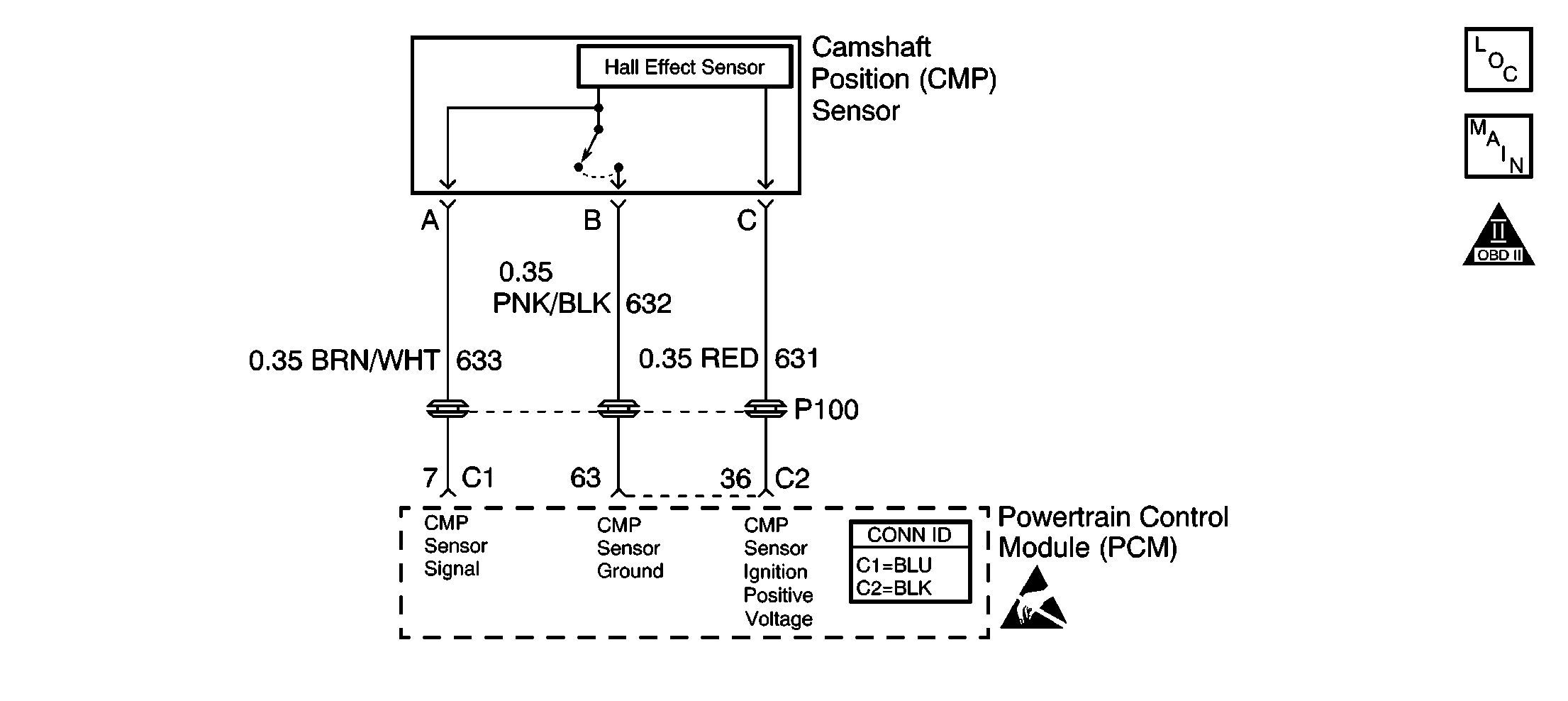
Circuit Description
The camshaft position (CMP) sensor correlates the crankshaft to camshaft position so that the Powertrain Control Module (PCM) can determine which cylinder is ready to be fueled by the injector. The CMP sensor also determines which cylinder is misfiring when a misfire is present. If the PCM receives an intermittent signal from the CMP, the CMP Resync Counter will increment. When the PCM cannot use the information from the CMP sensor, a DTC is set and the PCM will fuel the engine using the Alternating Synchronous Double Fire (ASDF) method.
Conditions for Running the DTC
The engine is running.
Conditions for Setting the DTC
The CMP Active Counter is not incrementing.
Action Taken When the DTC Sets
| • | The malfunction indicator lamp (MIL) will illuminate after 2 consecutive ignition cycles in which the diagnostic runs with the fault active. |
| • | The PCM records the operating conditions at the time when the diagnostic fails. This information stores in the Freeze Frame and Failure Records buffers. |
| • | A history DTC stores. |
| • | The coolant fan turns on. |
Conditions for Clearing the MIL/DTC
| • | The MIL will turn off after 3 consecutive ignition cycles in which the diagnostic runs without a fault. |
| • | A history DTC will clear after 40 consecutive warm up cycles without a fault. |
| • | Use a scan tool to clear the DTCs. |
Diagnostic Aids
| • | An intermittent problem may be caused by the following conditions: |
| - | A poor electrical connection |
| - | A rubbed-through wire insulation |
| - | A broken wire inside the insulation |
| • | Thoroughly inspect any suspected circuitry for the following conditions: |
| - | Any backed out terminals |
| - | Any incorrect mating |
| - | Any broken locks |
| - | Any incorrectly formed connectors |
| - | Any damaged terminals |
| - | Any poor terminal-to-wiring connections |
| - | Any physical damage to the wiring harness |
Test Description
The numbers below refer to the step numbers on the diagnostic table.
-
This step determines if the DTC P0342 is the result of a hard malfunction or an intermittent condition.
-
This step determines if the voltage is available to the CMP sensor through the PCM.
-
This step determines if the voltage is available to the CMP sensor through the PCM.
-
This step tests the output of the CMP sensor. If there is a varying voltage, then the problem is in the CMP signal circuit. If there is no varying voltage, then problem is in the CMP sensor electrical connections or is a malfunctioning CMP sensor.
-
The replacement PCM must be programmed and the Crankshaft Position System Variation Learn procedure must be performed.
Step | Action | Value(s) | Yes | No | ||||||
|---|---|---|---|---|---|---|---|---|---|---|
1 | Did you perform the Powertrain On-Board Diagnostic (OBD) System Check? | -- | Go to Step 2 | |||||||
Does the CMP Active counter increment? | -- | Go to Step 3 | Go to Step 4 | |||||||
3 | Operate the vehicle within the Failure Records conditions and the Conditions for Running the DTC as specified in the supporting text. Does the DTC reset? | -- | Go to Step 4 | Go to Diagnostic Aids | ||||||
Does the test lamp illuminate? | -- | Go to Step 5 | Go to Step 6 | |||||||
Does the test lamp illuminate? | -- | Go to Step 7 | Go to Step 8 | |||||||
6 |
Did you find and correct the condition? | -- | Go to Step 18 | Go to Step 15 | ||||||
Important:: The DMM must be connected to Sensor ground to insure proper readings. Does the frequency vary within the specified range? | 0.5-2.6 Hz | Go to Step 9 | Go to Step 14 | |||||||
8 |
Did you find and correct the condition? | -- | Go to Step 18 | Go to Step 15 | ||||||
9 |
Does the test lamp illuminate? | -- | Go to Step 12 | Go to Step 10 | ||||||
10 |
Does the test lamp illuminate? | -- | Go to Step 13 | Go to Step 11 | ||||||
11 |
Did you find and correct the condition? | -- | Go to Step 18 | Go to Step 15 | ||||||
12 |
Did you complete the repair? | -- | Go to Step 18 | -- | ||||||
13 |
Did you complete the repair? | -- | Go to Step 18 | -- | ||||||
14 |
Did you find and correct the condition. | -- | Go to Step 18 | Go to Step 16 | ||||||
15 |
Did you find and complete the repair? | -- | Go to Step 18 | Go to Step 17 | ||||||
16 | Replace the CMP sensor. Refer to Camshaft Position Sensor Replacement . Did you complete the repair? | -- | Go to Step 18 | -- | ||||||
|
Important:: The replacement PCM must be programmed. Refer to Powertrain Control Module Replacement/Programming . Replace the PCM. Refer to Powertrain Control Module Replacement . Did you complete the repair? | -- | Go to Step 18 | -- | |||||||
18 |
Does the DTC reset? | -- | Go to Step 2 | System OK |
